Cyber Crime Awareness among College Students in Mangalore
Vajagathali M*, Navaneeth Kumar S and Balaji Narayan B
Department of Criminology and Forensic Science, School of Social Work, India
Submission: May 25, 2018; Published: July 01, 2019
*Corresponding author:Vajagathali M, Department of Criminology and Forensic Science, School of Social Work, Roshni Nilaya, Mangaluru, India
How to cite this article:Vajagathali M, Navaneeth Kumar S, Balaji N B. Cyber Crime Awareness among College Students in Mangalore. J Forensic Sci & Criminal Inves. 2019; 12(1): 555828. DOI: 10.19080/JFSCI.2018.11.555828.
Abstract
The aim of the study is to investigate the attention of cyber-crime among faculty students in Mangalore by focusing varied threats. In recent year’s law-breaking is a vast challenge all told areas together with national security, public safety and private privacy. To forestall from a victim of law-breaking everybody should fathom their own security and safety measures to safeguard by themselves. A well-structured form survey methodology is applied to investigate the faculty student’s awareness within the space of cyber security. This survey is going too conducted in varied disciplines of students in Mangalore by focusing varied threats like user id and word, virus, piracy, erotica, fraud and cyber laws. This survey examines the faculty student’s awareness and therefore the level of awareness concerning the safety problems and a few suggestions square measure set forth to beat these problems. Supported the info the disciplines were compared and located out the attention level among the students.
Keywords: Cyber-Crime; Cyber law; It Act 2000; Awareness
Introduction
Computer is one among the necessary general functions in today’s life for many reasons. Nowadays it’s utilized by the just about all the organizations, establishments and folks. The advancement of engineering provides such a lot of blessings and conjointly brings disadvantages too. Due to this development in a very tiny time it creates issues and challenges too. By victimization the pc nets many crimes have been occurred. The pc crime includes money fraud crimes, Cyber coercion, Cyber warfare, Cyber extortion, fraud, Hacking, ineligible downloading, Piracy software/websites. These styles of offences that deals with the cyber world which incorporates laptop security, data security, and mobile security too. In order to commit crime by a laptop and net to hurt any persons or people is thought as Cyber-crime. It’s been a retardant as early because the late Seventies. In 1978 the primary spam e-mail materialized and in 1982 the primary virus put in on apple laptop. Regarding 2000 complaints were received in 2006 concerning cyber-crime. The 3 major complaints were money fraud, viruses and hackers. Children are being exposed to unwanted erotica, net harassment and bullying has been a perpetually inflated has been found. Day by day the usage of net continues to rise throughout the world; the threat of cyber-crime conjointly grows. These crimes are comparatively harmful whereas some aren’t abundant serious. The harmful crimes are Hacking, fraud, Cyber coercion, Virus dissemination, erotica, and Cyber forgery.
During this analysis, we’ve to look at the notice level of cyber-crime among school students in Mangalore town. Youth is that the backbone of Asian country, they ought to their rights and rights to grasp about this type of crime occur within the society. In India, there are 5 major academic disciplines are playing a crucial to engineer a student generation. Majority of the Indian school students are taking those 5 fields and commenced their career with the assistance of revered establishment. Those 5 disciplines are Arts, Science, Engineering, Medical and Law. During these 5 disciplines the participants are taken for our analysis and see the notice level of the cyber-crime and IT act 2000. Form methodology is going to be wont to collect the info for this analysis and victimization method to research the info. In Mangalore town, we’ve designated arbitrarily a hundred and fifty school students in several schools consistent with the disciplines. Through the applied math analysis, we have a tendency to be attending to examine the notice level of individual disciplines and see that discipline can get high result and that discipline can get the less awareness regarding the cyber-crime [1].
Materials and Methods
Ethical statement
I hereby declare that this research project entitled “Cyber Crime Awareness among college students, Mangalore” is a bona-fide research carried out by me and my co-partner under the guidance of Mr. Balaji Narayan B, Assistant Professor, Department of Criminology and Forensic science, school of Social Work, Roshni Nilaya Mangalore. The present study aims to understand cyber-crime awareness among college students, Mangalore
Objective
The objective of this study is to educate and create awareness among the student’s community on use of technology, internet, social media and its implications on possible cybercrimes
Problem statement
The purpose of the research was to find out the knowledge of cyber and its terms among college students. As the cybercrime increasing day by day, there arises the need to improve the knowledge about cyber and to avoid being victim of the cyber-crime. The study was an attempt to find out whether the students of Mangalore are aware of cyber and its crime. The study can help management to know about the knowledge of students in cyber.
Research design
The research design is a conceptual structure within the research study is undertaken. The preparation of such design facilitates research to be as effective as possible yielding maximum information. Questionnaire based method will be employed for the study.
Scope of the study
The scope of the study is to explore, create awareness and gain more knowledge about the cybercrime. Also examine the level of ethical and security awareness among college students
Universe, sample and sampling techniques
For the purpose of this study, the UG and PG students of Mangalore will be taken as universe. In the present study, the term respondents are referred to students of Mangalore. The selected respondents are technically called “sample” and the selection process is called “sampling techniques‟. For the purpose of the study the investigator has selected the investigator has selected 150 different disciplines students of UG and PG in Mangalore. The sample is selected through “Simple Random Sampling Method”. The students are randomly chosen as respondents. Age of the respondents is distributed from 18-28 years
Tools of data collection
A tool is an aid with necessary and relevant information could be gathered systematically to the subject matter. The tool was decided on the basis of the objectives of the study. The Questionnaire method (Annexure) will be the tool of data collection, which will be used by the researcher for the purpose of collecting data from the respondents. Questionnaire method is the best method for collecting the maximum information in a systematic method. In the present study, Descriptive Research or Survey method will be applied to describe and interpret what exists at present. It involves some types of comparison or contrast and attempts to discover the relationship between existing non-manipulated variables. The Survey method to educational problems is one of the most commonly used approaches
Data collection procedure
The respondents of the study were taken from Mangalore city. The respondents were divided based on different educational fields i.e. Arts, Science, Medical, Engineering and Law students of UG and PG students. Around 30 respondents from each field consists of totally 150 respondents by using questionnaire method. Both male and female respondents were considered for the study. The data was collected by simple random sampling method. Opinion and views of the respondents were collected through the Questionnaire method. The investigator after building an understanding with the respondents described the purpose, importance and significance of the study. The questionnaire was filled in the presence of researcher so that researcher could clarify the doubts of respondents regarding the questions.
Results and Discussions
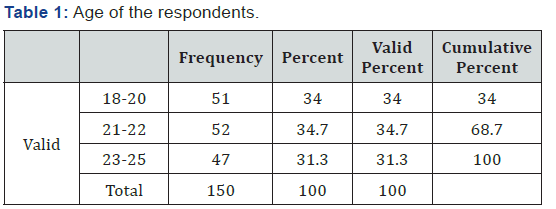
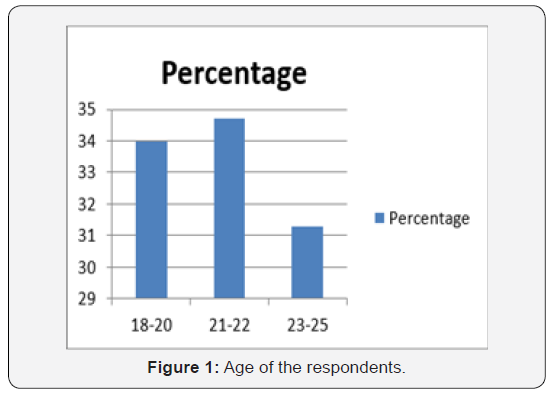
The age of the respondents, 34% of the respondents belong to age group of 18-20 years, in Table 1 34.7% of the respondents belong to age group of 21-22 years and 31.3% of the respondents belong to age group of 23-25 years Figure 1.
Awareness on user Id and password
As shown in Table 2, percentage of the awareness level of User Id and Password among different discipline of students has been mentioned above. As per data highest awareness level was found in the discipline of Science, they have 26.7% followed by engineering and arts students have second highest value of 23.3%. Medical students having moderate level of awareness compared to above three disciplines. The value is about 16.7% respectively. Finally, law students have the lowest level of awareness which the value includes 10% Figure 2 [2].

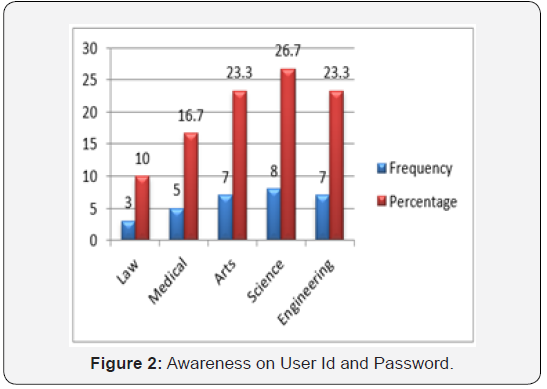
Awareness on computer virus
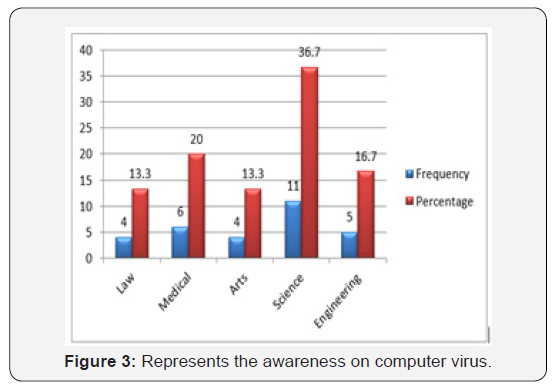
As shown in Figure 3, percentage of the awareness level of computer virus among different discipline of students has been mentioned above. As per data highest awareness level was found in the discipline of Science students have 36.7% followed by Medical students have second highest value of 20%. Engineering students having moderate level of awareness compared to above two disciplines in Table 3. The value is about 16.7 respectively. Finally, Law and Arts students have the lowest level of awareness which the value includes 13.3%.
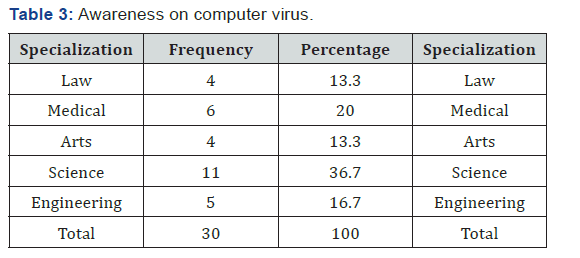
Awareness on Identity theft
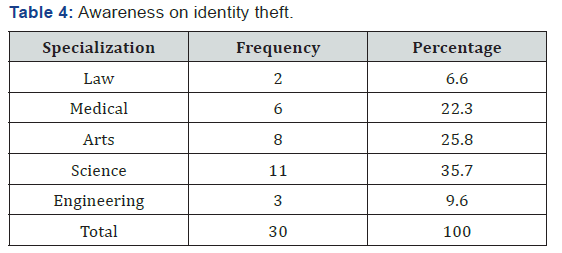
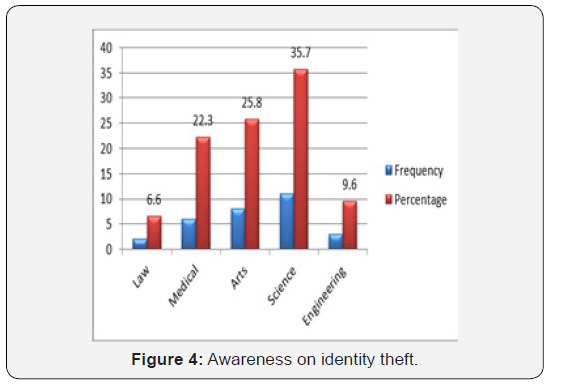
As shown in the above Table 4, percentage of the awareness level of Identity Theft among different discipline of students has been mentioned above. As per data highest awareness level was found in the discipline of Science students have 35.7% followed by Arts students have second highest value of 25.8%. Other three disciplines have moderate level of awareness which includes the percentage of 22.3, 9.6 and 6.6 respectively Figure 4 [3].
Awareness on piracy
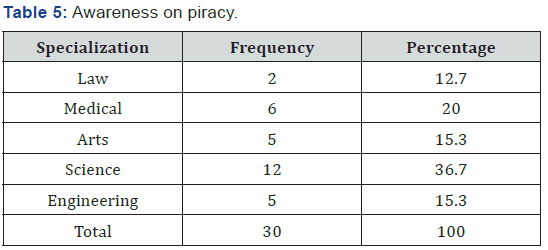
As shown in the above Table 5, percentage of the awareness level of Piracy among different discipline of students has been mentioned above. As per data highest awareness level was found in the discipline of Science students have 36.7% followed by Medical students have second highest value of 20%, Arts and Engineering students having moderate level of awareness which includes the percentage of 15.3 and 153.3 and law students have only 12.7% of awareness respectively Figure 5[4].

Awareness on pornography
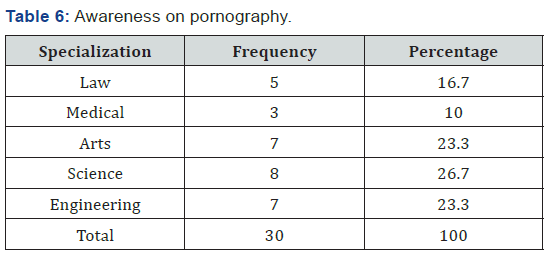
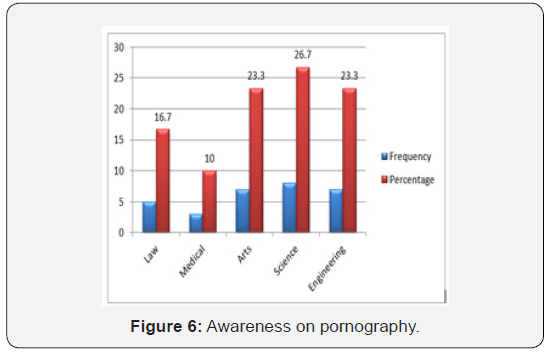
As shown in above Table 6, percentage of the awareness level of Pornography among different discipline of students has been mentioned above. As per data almost all the disciplines have highest level of awareness about the Pornography. The percentage includes Science students have 26.7%, Arts and Engineering students have 23.3% , Law students have 16.7% and Medical students have 10% Figure 6 [5].
Awareness on cyber crime laws
As shown in the above Table 7, percentage of the awareness level of Cyber Crime Laws among different discipline of students has been mentioned above. As per data highest level of awareness was found in the discipline of Science and Arts students have 23.3% followed by Engineering students have second highest value of 20%.Law students having 20% and Finally Medial students having 12.7% respectively Figure 7.
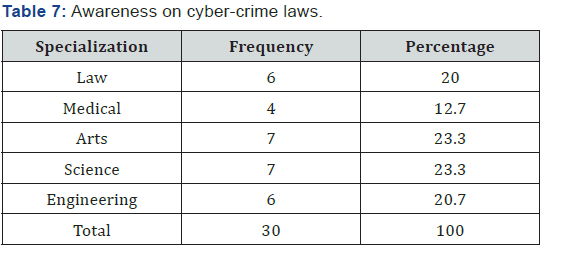
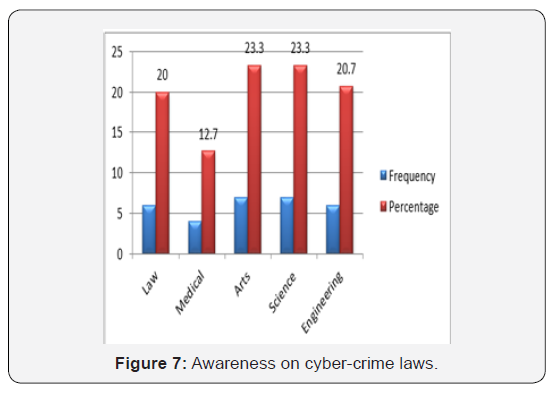
Awareness among all the disciplines
As shown in the above Table 8, researcher compared all the disciplines and found out that which discipline have the higher awareness and which got low level. As shown in the Figure 8, after comparing the disciplines researcher got the highest percentage awareness level in Science group.
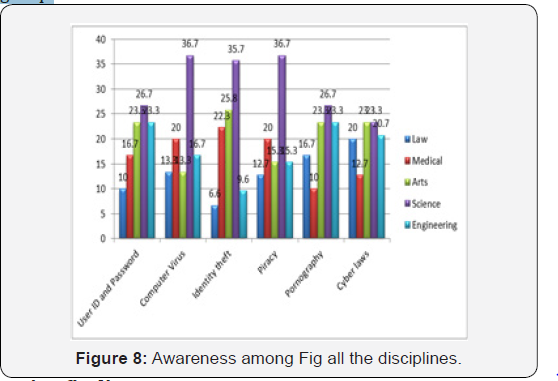
Major findings
a. Maximum number of respondents were from the age group of 21-22. b. Majority of the respondents are from Mangalore only. c. Majority of respondents have the high level of awareness in the Pornography. d. There is a lack of knowledge about computer virus among the respondents. e. As per our objective researcher found out the awareness level of cyber crime among college students in Mangalore has been successfully examined. The researcher also the compared the awareness level of cyber crime among different disciplines like Law, Medical, Arts, Science and Engineering.

Suggestions
a) Use a full service suite b) Use strong password and include all the characters c) Keep your antivirus software updated d) Manage your social media setting and keep your information locked down e) Talk to your neighbours, collegues, parents, childrens, friends and relatives about the cyber crime and cyber crime laws. f) Take precaution measures to help protect yourself against identity theft g) Keep an eye on the kids whether they are using inappropriate surfing in the internet. h) Make backups of important files and folders to protect important files and records on your computer if your computer malfunctions or is destroyed by a successful attacker. i) As cyber-crime is the major threat to all the countries worldwide, certain steps should be taken at the international level for preventing the cyber-crime.
Conclusion
On the basis of findings of present work it could be concluded that there is a significant difference between the awareness level of different disciplines. Results revealed the importance of awareness as a tool to decrease/prevent cyber-crime. The overall findings indicate that the Science students have high level of awareness compared to other disciplines. Therefore it is concluded that todays generation moderately most of the students have the basic knowledge about the computer and its crime.
Acknowledgement
We would like to express my sincere heartfelt gratitude and thanks to our Insititution School of Social Work, Roshni Nilaya for providing us with the platform. With our regards and respect, we take this oppurtunity to thank our mentor and research supervisor Mr. Balaji Narayan B, Assistant Professor, School of Social Work, Roshni Nilaya for providing us with the necessary guidance, encouragement and suggestions when required and also for the steering us in the right direction. We would like to thank Ms. Saritha D’Souza, Head and Ms. BhavyashreeRai, Lecturer, Post Graduate Department of Criminology and Forensic Science, School of Social Work, Mangaluru, for their constant support in our research work. Our sincere thanks to Ms. Juliet C J, Principal, School of Social Work, Mangaluru, for giving us the opportunity to undertake this study.We sincerely thank participants for their support and cooperation during data collection. We would like to thank our family for the constant encouragement and support throughout our life and academic career.
References
- Senthilkumar K, Easwaramoorthy S. (2017) A Survey on Cyber Security awareness among college students in Tamil Nadu. In: Materials Science and Engineering Conference Series 263: 4.
- Manisha Kumbhar, Vidya Gavekar (2017) A Study of Cyber Crime Awareness for Prevention and its Impact. International journal of recent trends in engineering and research. In: Monalisa Hati (Eds), Cyber Crime: A Threat to the Nation and its Awareness. International Journal of Advanced Research in Computer and Communication Engineering.
- Afrozulla Khan Z, Vaishnavi Rajesh Thaku, Arjun (2018) Cyber Crime Awareness among MSW Students, School of Social Work, Mangaluru. JFSCI 9(2): 1-7.
- Jose T, Vijayalakshmi Y, Babu S, Manimegalai P (2016) Mobile crimes in India: A survey. In 2016 International Conference on Signal Processing, Communication, Power and Embedded.
- Verma A (2012) Cyber pornography in India and its implication on cyber cafe operators. Computer Law & Security Review 28(1): 69-76.






























